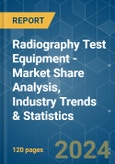The Radiography Test Equipment Market size is estimated at USD 1.22 billion in 2024, and is expected to reach USD 2.12 billion by 2029, growing at a CAGR of 11.75% during the forecast period (2024-2029).
The Coronavirus (COVID-19)pandemic has affected every aspect of life globally. This has brought along several changes in market conditions and affected the manufacturing and automotive sector for the market majorly. According to the Ministry of Statistic and Program Institute (MOSPI) India, the impact of COVID-19 on Gross value-added on the construction, manufacturing, and mining sector has accounted for -13.3%,-6.3%, and -14.7%, respectively. Thus, the decline in the growth of these industries has reduced the demand for the radiography test equipment process activities that impact the market growth.
This product will be delivered within 2 business days.
The Coronavirus (COVID-19)pandemic has affected every aspect of life globally. This has brought along several changes in market conditions and affected the manufacturing and automotive sector for the market majorly. According to the Ministry of Statistic and Program Institute (MOSPI) India, the impact of COVID-19 on Gross value-added on the construction, manufacturing, and mining sector has accounted for -13.3%,-6.3%, and -14.7%, respectively. Thus, the decline in the growth of these industries has reduced the demand for the radiography test equipment process activities that impact the market growth.
Key Highlights
- Increase in demand from aerospace and automotive sectors, primarily due to conformance to high industry standards and safety regulations is boosting the adoption of radiography testing solutions.
- The shift from analog to digital technology has given the industrial radiography market a new lease of life for NDT applications, broadening the scope of X-ray inspection systems beyond traditional applications.
- Companies are increasingly focusing on reducing radiation-related risks, and preferring portability solutions, which has prompted companies to revamp their product portfolio. For instance, Samsung has adopted radiography to test their batteries after the much-publicized Note 7 fiasco.
- Incidents, like the BP Macondo disaster, the San Bruno pipeline explosion, and the BP Texas City refinery explosion, have further emphasized on the need for safety, environmental sustainability, therefore governmental agencies and regional bodies like ASME & ISO have taken stringent measures to assure safety and regulatory compliances.
- Intense competition from ultrasonic systems, high risk of radiation, lack of skilled personnel, to handle radiography equipment which uses gamma rays (especially in digital radiography). Also, relatively high deployment costs are expected to hinder the growth of the study market.
Radiography Test Equipment Market Trends
Application in Aerospace to Account for a Significant Portion of the Market Demand
- Radiography test equipment, mainly used in manufacturing and maintenance of military and civil aircraft, are considered under the scope of the aerospace segment.
- Applications in aerospace, include detection of internal defects in thick and complex shapes, in metallic and non-metallic shapes, quality of critical aerospace components, structures, and assemblies.
- Increasing emphasis on safety standards, decreasing service intervals, low emission targets, and the advent of new materials and process are the major factors driving the radiography market in the aerospace segment.
- Conventional radiography is being increasingly replaced with digital radiography in aerospace, and the latter is expected to completely overshadow the market, except for some critical high-resolution imaging applications.
- This shift has also been fuelled by the advent of common binding standard for the common accreditation, in accordance with the National Aerospace and Defense Contractors Accreditation Program (NADCAP).
North America to Account for Significant Market Share
- The region is home to some of the major players in the market, coupled with the extensive research and development activities that have resulted in the wide-scale adoption of non-destructive testing.
- As the United States is one of the early adopters of manufacturing automation, the use of automated solutions in some regions of testing is expected to address the issue of lack of skilled personnel, by releasing workers from hard and dangerous, repetitive, and monotonous work.
- NTS with 28 labs in North America, provides custom testing to meet FDA, product safety, and other essential certifications to bring products to market quickly to medical device and equipment manufacturers. The testing varies from bigger devices to smaller implants that are then implanted in the human body and thus need robust testing methods. For instance, the company provides component analysis, standard radiography, and computer tomography (CT) of hearing implants.
- Furthermore, the Canadian GDP is majorly dominated by the oil and gas sector to capital investments and exports. Attractive provincial incentives to encourage drilling and increased implementation of long horizontal wells and multistage fracturing in shale resources are the major drivers for the Canadian oil and gas industry.
Radiography Test Equipment Industry Overview
The major companies like YXLON International, GE Measurement and Control, Nikon Metrology Inc., Teledyne Dalsa Inc., Hamamatsu Photonics K.K., Canon Inc., Hitachi Ltd, among others. The market is fragmented due to the intense competition among the major players since they are investing significantly in the R&D for immeasurable accuracy in their equipment. Therefore, the market concentration will be low.- March 2020 - The GTMA formed a cluster of member companies interested in working in the medical sector, anticipating the need for an immediate response to the COVID-19 pandemic and ongoing medium/long-term growth in the global requirement for medical devices and other manufacture.
- December 2020 - The Indian government planned to set up three large manufacturing zones for power and clean energy equipment by offering companies incentives such as land and electricity at attractive prices, power, and new and renewable energy. Such initiatives by the government are expected to boost the investment in equipment, leading to the growing demand for equipment testing, including radiography testing equipment.
Additional Benefits:
- The market estimate (ME) sheet in Excel format
- 3 months of analyst support
This product will be delivered within 2 business days.
Table of Contents
1 INTRODUCTION
4 MARKET DYNAMICS
5 MARKET SEGMENTATION
6 COMPETITIVE LANDSCAPE
Methodology

LOADING...








